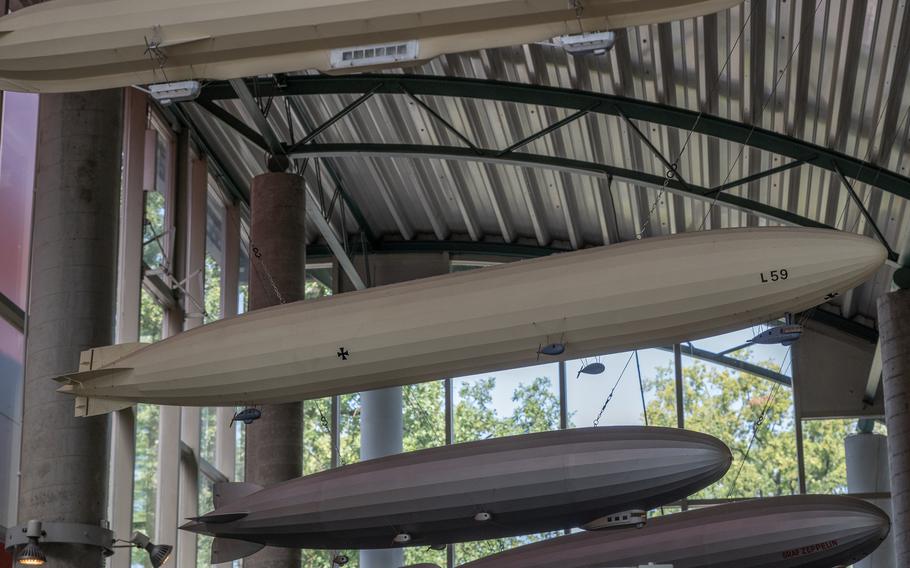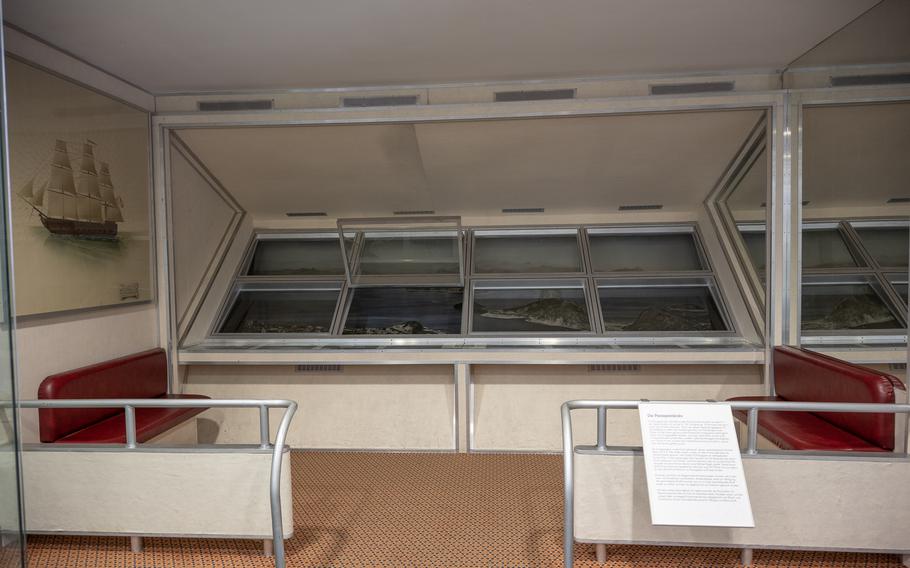
Models hanging from the ceiling of the Zeppelin Museum in Neu-Isenburg, Germany, show several variations of the famous airships. The LZ 10 Schwaben, which debuted in 1911, was used as a commercial airship by DELAG, the world's first airline. Behind it is the L59, a military airship used in World War I. (David Edwards/Stars and Stripes)
Radio broadcaster Herbert Morrison’s “oh, the humanity!” exclamation amid the 1937 Hindenburg disaster sounded in my mind recently as I gazed at an exhibit near the German ground where the airship’s ill-fated voyage had begun.
One of my earliest introductions to the news media’s impact came when a TV program I saw as a kid showed newsreel footage of that zeppelin inferno in Lakehurst, N.J.
Despite the enduring recollection, I had never really delved into the prelude that saw German airships help usher in the age of global aviation. Hence my visit to the Zeppelin Museum in what is today Neu-Isenberg but before a 1977 merger was Zeppelinheim.
Meaning “zeppelin home,” it was originally a company town built to house employees of the Rhein-Main airship base, now part of the Frankfurt Airport territory. Less than 25 minutes from Clay Kaserne in Wiesbaden and about an hour and 15 minutes from Kaiserslautern, the museum is tucked into a leafy, bucolic neighborhood and has a bike path running next to it.
The sunny tranquility on the day of my visit was unexpected, given that Zeppelenheim is on the doorstep of one of the world’s busiest air hubs.
Just past the museum entrance is a bust of the namesake airships’ creator, Count Ferdinand von Zeppelin. On either side of the sculpture and the information counter behind it are exhibit spaces, with models of the Hindenburg, the Graf Zeppelin and others hanging overhead.
Among them is the LZ 126, a passenger dirigible that was delivered to the United States in 1924 as part of Germany’s World War I reparations. After arriving to great fanfare, the craft became the naval airship USS Los Angeles, which was in service until 1932.
The upstairs and downstairs floor space is covered with cool memorabilia from the days when the zeppelins of Deutsche Luftschiffahrts-Aktiengesellschaft, or DELAG, the world’s first airline, plied the skies and created the commercial aviation industry.
Following the transfer of the LZ 126 to the U.S., the boss of DELAG, Hugo Eckener, charted a new course of becoming an overseas air carrier of passengers. That task fell to the LZ 127, or Graf Zeppelin.
Between 1928 and 1937, this airship made 590 journeys, including one around the world in 21 days, and carried more than 13,000 passengers without ever having an accident.
The circumnavigation spawned a board game introduced in 1929 called Banzai Zeppelin. Players tried to figuratively complete the journey faster than Eckener did. It came with a route map and broke up the trip into four destinations: New York, Los Angeles, Tokyo and the departure point of Friedrichshafen, Germany.
In 1936, the Hindenburg entered service. Its trans-Atlantic flights from Frankfurt served North and South America. The museum has a mockup of the passenger deck with two seats and a view out the windows of Rio de Janeiro.
Only 3,059 passengers were transported aboard the airship during its 63 total trips, the last of which ended in tragedy on May 6, 1937. The Nazis had used both aircraft for propaganda purposes, but the explosion of the Hindenburg brought about the demise of the airship age.
The exhibit on the Hindenburg disaster features pictures of the burning dirigible, a fragment of the mooring tower and a bow lamp.
All the text in the museum is in German, but an explanatory booklet in English is available at the counter. There’s no charge to use it during a tour. Keeping it costs 5 euros, which I thought was a fair price.
Another revelation awaited in the basement, where a collection of Americana introduced me to the partnership that resulted in the Goodyear Zeppelin Corp.
This venture, which lasted from 1924 to 1941, led to the creation of rigid airships like the zeppelins and non-rigid airships, or blimps, for the U.S. military.
I read in the museum booklet that Goodyear also had a hand in the revival of zeppelins in the 1990s by a Friedrichshafen maker of semi-rigid airships known as the Zeppelin NT. Of the five such aircraft in service worldwide in 2019, three belonged to Goodyear and operated in America.
The exhibit evoked memories of another airship that I had seen on TV many times as a kid watching sporting events: the Goodyear blimp. I was amazed to learn of both the military forebears and German lineage of this American branding icon.

An exhibit at the Zeppelin Museum in Neu-Isenburg, Germany, shows a scaled-down version of the Hindenburg's passenger deck. Looking through the windows gives museum visitors a simulated view of what airship passengers over Rio de Janeiro saw. (David Edwards/Stars and Stripes)
On the QT
Address: Kapitän-Lehmannstrasse 2, Neu-Isenburg, Germany
Hours: Tuesday through Friday, 2-5 p.m.; Saturday and Sunday, 11 a.m.-5 p.m. Closed Monday
Costs: No fixed admission price. Free-will offerings accepted. Informational booklets are free to rent, 5 euros to keep.
Information: Phone: +49 69 69595978 Online: zeppelin-museum-zeppelinheim.de/html/en_museum.html